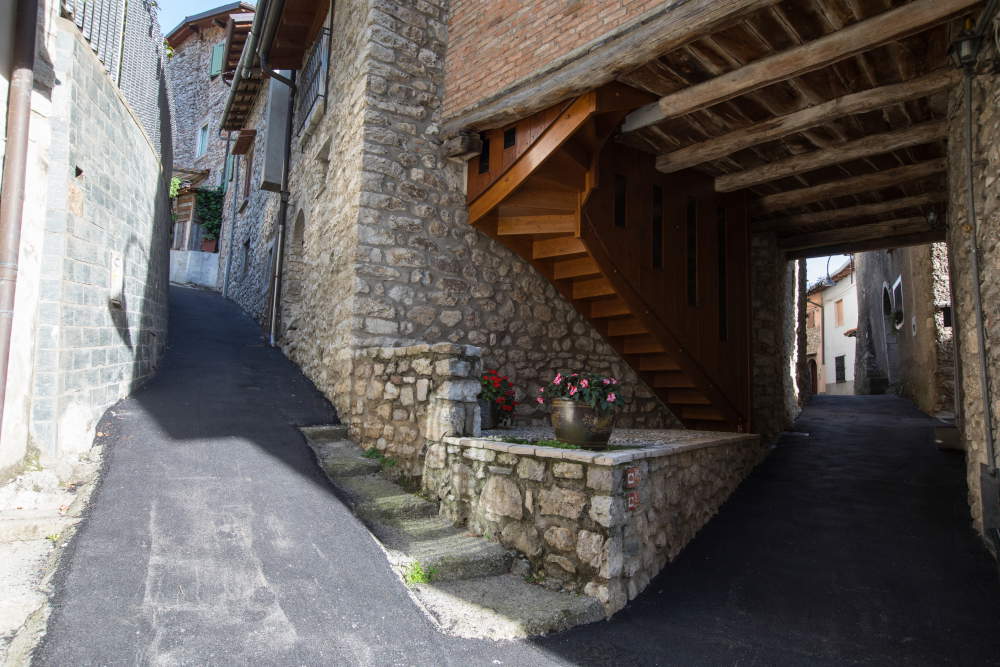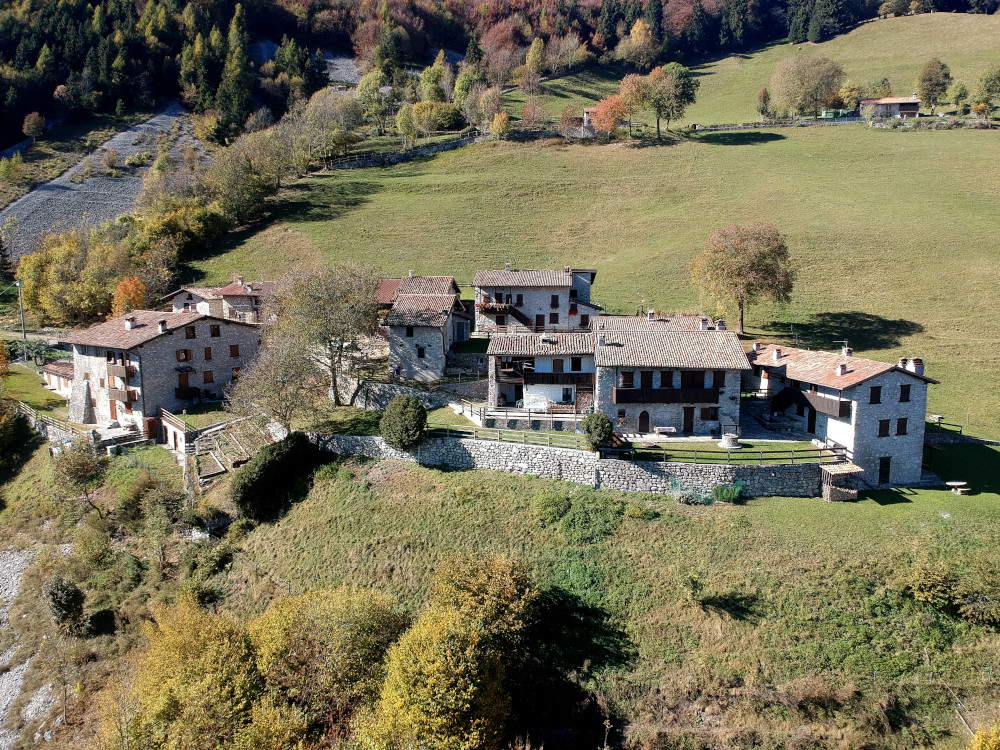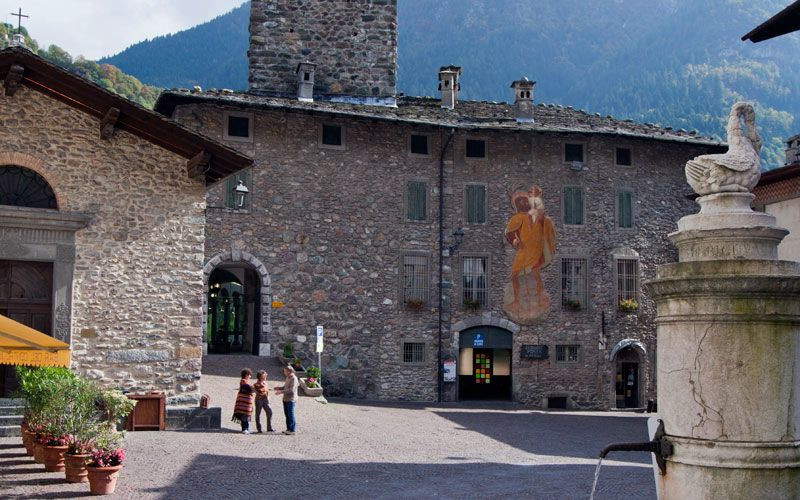Less than an hour from Bergamo, between the ValSeriana, the alpine valley of the Serio river basin and which, starting from Bergamo, extends northeastward for some sixty kilometers, and the Val di Scalve, the valley of the Dezzo stream in the Orobie Orientali Alps that stretches for a width of nineteen kilometers occupying the extreme northeastern corner of the province of Bergamo, one finds small, enchanting villages that offer evocative views, artistic and architectural works to discover, ancient knowledge to learn about, but also stories of the valleys’ past and of characters who intertwined their existences and creative genes here. Stories that, layered over the centuries, have created an artistic geography that deserves to be discovered slowly, in villages that at this time of the year dress up to become even more graceful and evocative.
Among them is Olera, a medieval village located about five kilometers from the center of Alzano Lombardo, in a small side valley, parallel to the Nesa valley, which slopes down from the slopes of Canto Alto and lies between the Zuccone and Colletto mountains. The village, surrounded by the hilly landscape, is characterized by a group of houses leaning against each other around the parish church and a succession of arches, alleys, small windows and doorways that meet in its center surrounded by pedestrian streets. We start from Fra Tommaso da Olera Square (the village was in fact the birthplace of Blessed Tommaso Acerbis (Olera, 1563 - Innsbruck, 1631), among the most interesting mystics of the 17th century belonging to the Order of Friars Minor Capuchin, who distinguished himself by his t as a preacher, his humility, and his fame as a thaumaturge and writer), and then on to the main points of the village, such as the church of St. Bartholomew the Apostle, which houses a splendid polyptych made by Cima da Conegliano in 1495 perhaps commissioned by the Olerese stone cutters active in the Veneto region. It is an astonishing work for its profusion of gold and highly refined painting, particularly note the central panel with the tender and sweet Madonna and Child. The nearby ancient little church of the Holy Trinity, on the other hand, preserves an altarpiece depicting theCoronation of the Virgin recently attributed to Pase Pace, an artist about whom little is known: the year and place of birth of this painter, son of Filippo, active in Venice from the last decade of the 16th century, are unknown. Finally, crossing through the village, we come to the church of San Rocco, located beyond the village, in a position that opens a beautiful view of the valley below.
Then there is Borgo Taramelli, the heart of Selvino, which can be accessed either from the side of the Del Piccinini Café, thus passing through a narrow alleyway overlooked by ornate doorways, balconies, window sills, stairways, windows and mullioned windows with two lights, or from the central Via Monte Rosa, which finally opens onto the small square named after Guglielmo Marconi. From here one arrives at a large courtyard, enclosed by a low wall: this is the perimeter on which, until the early twentieth century, a stable was built and used by the inhabitants of the village. The central building is one of the oldest buildings in Selvino, dating back to the early sixteenth century. The former Albergo Falcone, Selvino’s first hotel, was made out of this old block of flats, which in the early twentieth century was taken over by one of the Taramelli brothers, and at the same time the stable was torn down. It is by passing through the double porch, however, that one reaches an archway with a canopy resembling a small suspension bridge called “Canècc,” which serves as the internal gateway to the village proper. To the left of the arch is visible the line of an arch closed by a French door, and on top of that line is a stone coat of arms bearing the date 1563, with three stylized symbols and a larger one in the center. Above this coat of arms is a painting, now restored, depicting a Madonna and Child dating from the same period. The arch with the coat of arms was the ancient door of the first core of the former Falcone Hotel.
An unmissable stop if you are exploring the villages of this area is certainly Clusone, among the Most Beautiful Villages in Italy and an Orange Flag of the Italian Touring Club. Also known as the Painted City, due to the many frescoes found on public and private buildings in the historic center, Clusone offers its visitors an enchanting glimpse of the Piazza dell’Orologio, named after the Fanzago Clock located on the Town Hall Tower, which has been periodically animated by video projections since last year. The Fanzago Clock was designed in 1583 by Pietro Fanzago and is still wound manually today, indicating the hours, months, days, length of day and night, signs of the zodiac and phases of the moon with a single hand that rotates counterclockwise. But Clusone has much more to offer: the Basilica of Santa Maria Assunta and the Oratorio dei Disciplini on whose facade one of the symbols of Clusone art, the Danza Macabra, can be seen. A unique work in Europe, it has been frescoed on the facade since 1485 (as noted in the first scroll on the left). It is to be regarded as a kind of anthology of 15th-century macabre themes united in a single representation: at the top the Triumph of Death, in the center the Dance Macabre in the form of a slow procession in which each individual is accompanied by his or her own skeleton, and at the bottom a kind of Last Judgment, which, however, is now almost completely lost. From the churchyard of the Basilica you can admire the view of the plateau and plateau of St. Lucius, until you meet the small church of the Trinity located on the Crosio hill. In the historic center you will be fascinated by the many noble palaces and minor churches, until you reach the MAT - Museo Arte Tempo, where a collection of very rare tower clock mechanisms is preserved, as well as works ranging from canvases to sculptures, drawings and overhangs, set up among the galleries and frescoed vaults of the Palazzo Marinoni Barca.



If you want to immerse yourself in a place of peace, reconnecting with nature, savoring the slow rhythms of mountain life and enjoying the view of the Giants of the Orobie Mountains, you must visit the ancient mountain hamlet of Cacciamali, located in Ardesio, 1030 meters above sea level on the slopes of Mount Secco. You get there on foot from a dirt road with a walk of about an hour, accompanied by the words of Dino Buzzati that you will find in the nine Signs of Culture, nine stages that mark the way.
Another Borgo among the Most Beautiful Villages in Italy and Orange Flag of the Touring Club is Gromo, located toward the northernmost part of the ValSeriana. The medieval village is also known as Little Toledo for the production of white weapons that were forged here in the past. Its structure is typical of mountain villages, characterized by alleys and stone houses with balconies and loggias. Places to visit include the 12th-century Parish Church of St. James the Apostle; Piazza Dante, the beating heart of the village, with the 15th-century Town Hall; and also, the ancient Ginami Castle erected in 1226, which still preserves its 14th-century tower in rustic ashlar; the small church of St. Gregory, probably built as the Ginami Castle’s private oratory; and, finally, a must-see, the 16th-century marble fountain next to the town hall, surmounted by a swan, the symbol of Gromo. The visit to the village can only conclude then with the MAP - Museum of White Arms and Parchments, set up in the frescoed rooms of Palazzo Milesi, where through the collections of finely crafted blades, weapons on auction and historical parchments it is possible to reconstruct the production system that originated in the mining of iron ore in the territories of Valbondione, in the roasting of ore in the Fom Negher locality and finally in the production of swords in the Gromese forges along the Goglio stream.
To conclude with Azzone, in the Scalve Valley, about fifty kilometers from Bergamo. The recently renovated Civic Tower of medieval origin is worth seeing; about fifteen meters high, it is built of squared boulders and is the main figure in the municipality’s coat of arms. There is also the parish church dedicated to St. Philip and St. James, rebuilt between 1724 and 1733 and enlarged in 1860, which houses some works by the Clusonese Antonio Cifrondi. By the late Baroque painter is also the Madonna addolorata that can be admired in the Church of Santa Maria Maddalena perched in the hamlet of Dezzo, the last stop on this journey among the most beautiful villages between ValSeriana and Val di Scalve, to immerse oneself in the culture of the Magnifiche Valli.
More information on the history and culture of the ValSeriana and Val di Scalve can be found at https://www.valseriana.eu/arte-e-cultura/
Activity realized with the contribution of the Lombardy Region as part of the OgniGiorno inLombardia call for proposals, project Campaign “The Magnificent Valleys between Bergamo and Brescia Italian Capital of Culture 2023.”



 |
| Discovering the most beautiful villages between ValSeriana and Val di Scalve |
Warning: the translation into English of the original Italian article was created using automatic tools. We undertake to review all articles, but we do not guarantee the total absence of inaccuracies in the translation due to the program. You can find the original by clicking on the ITA button. If you find any mistake,please contact us.